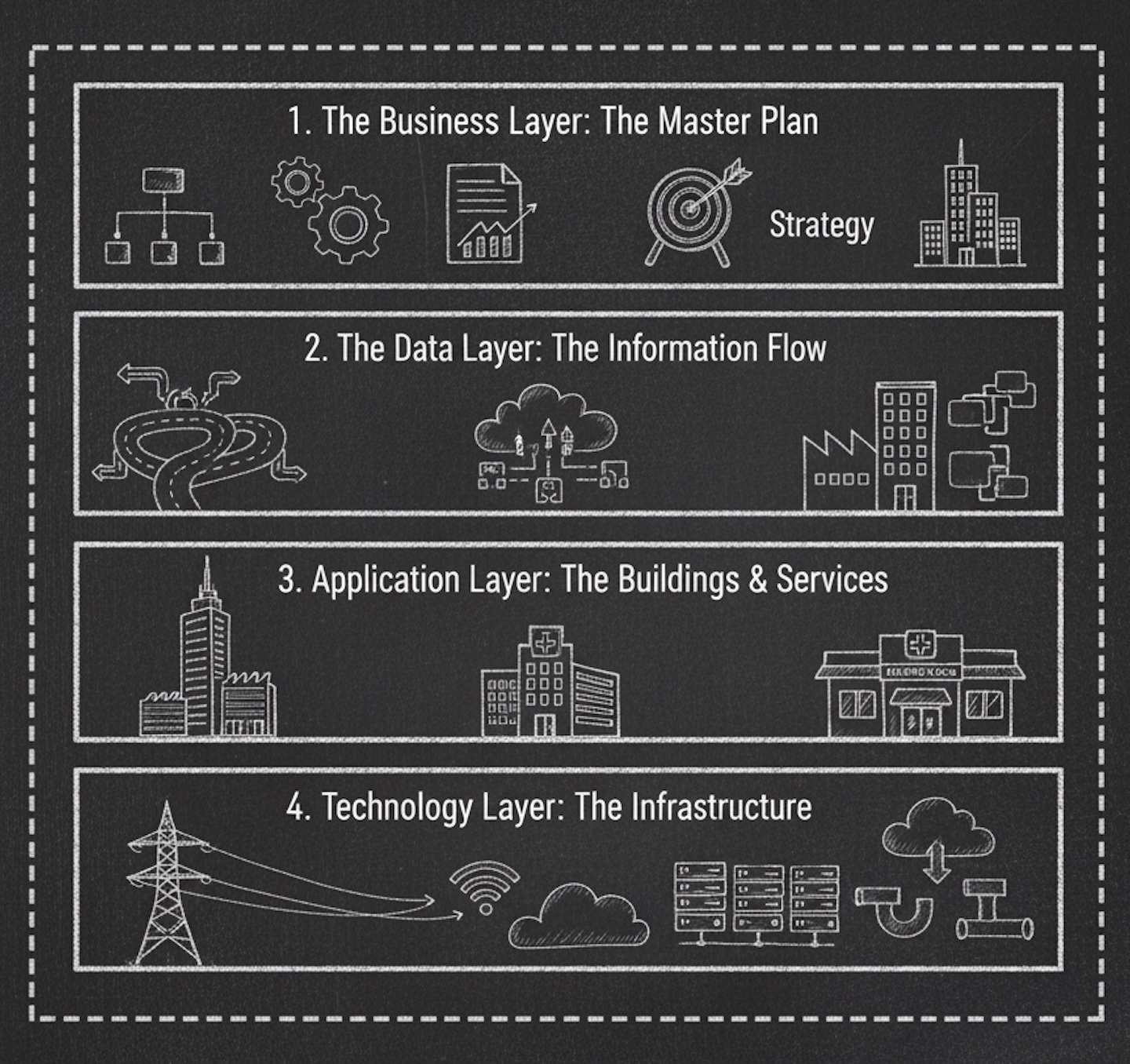From Chaos to a Coherent City: The Power of Enterprise Architecture
Oct 9, 2025

From Chaos to a Coherent City: The Power of Enterprise Architecture
October 9, 2025
Picture this: your company just launched a new app, but marketing cannot access customer data, finance is still working in spreadsheets, and IT is constantly fighting integration issues. Sound familiar?
Many businesses grow this way, expanding layer by layer and team by team, without a clear blueprint. What starts as agility often turns into inefficiency and confusion. It is like adding a new room to a house without planning for plumbing or access. Soon, a change in one area threatens the stability of the entire structure.
The Big Idea: Strategic Urban Planning for Your Business
Imagine two cities.
The first city grew organically. Buildings appeared wherever space allowed, roads twisted aimlessly, and infrastructure was patched together as needed. The result is traffic jams, power outages, and constant frustration.
The second city was designed by visionary planners. Roads flow smoothly, districts are organized, and every part of the infrastructure works in harmony. It is resilient, efficient, and ready for growth.
The difference between these two cities is a blueprint, a master plan that guides every decision. In the business world, that blueprint is Enterprise Architecture (EA).
EA is not about complex jargon or rigid frameworks. It is about strategic design, applying the principles of urban planning to your organization. It defines where you are, where you want to go, and how to get there in a coherent and sustainable way.
It is not about stifling innovation with bureaucracy. It is about aligning innovation with purpose.
Breaking Down the Blueprint: The Four Core Layers
A city’s blueprint is not a single map. It is a collection of plans that together shape how people live, move, and thrive. In the same way, your business blueprint has four interconnected layers.

1. The Master Plan – Business Architecture
Before the first road is built, urban planners define the city’s purpose. Will it be a financial hub, a residential community, or a center for technology? They set zoning laws, plan districts, and determine how services will flow.
This is your Business Architecture, the foundation that defines why you exist and how you create value. It aligns strategy, goals, and core processes, forming the master plan for how your organization operates and grows.
2. The Traffic and Information Flow – Data Architecture
Once districts are planned, the city needs roads, the arteries that connect everything. In a business, those roads represent your data flows.
Your Data Architecture ensures that information moves smoothly between departments, systems, and users. Without it, you end up with traffic jams or data silos where information becomes stuck and loses value.
3. The Buildings and Services – Application Architecture
With the roads in place, it is time to build the city: schools, hospitals, offices, and marketplaces. Each has a purpose, but all must connect to shared infrastructure.
This is your Application Architecture, the software and systems employees use every day. Well-designed applications are like well-placed buildings. They fit their environment, connect to shared resources, and enhance the experience of the people who use them.
4. The Infrastructure – Technology Architecture
Finally, beneath it all lies the invisible foundation: the roads, the power grid, the water pipes, and the communication lines.
This is your Technology Architecture, the servers, networks, cloud platforms, and security layers that support everything above. It is unseen but indispensable—the infrastructure that keeps your city running.
The Big Picture: From Chaos to a Thriving City
Without a blueprint, a business grows into a sprawling and inefficient maze, a fragile house of cards where one small change can trigger a chain of failures. Decisions made in isolation lead to redundant costs, fragmented systems, security risks, and slow project delivery.
Enterprise Architecture transforms that chaos into coherence.
It turns fragmented growth into an integrated ecosystem, a well-planned, scalable, and resilient city that evolves gracefully. It helps leaders make smarter investments, prioritize strategically, and enable innovation without creating disorder.
EA is not about micromanagement. It is about visionary design—thinking like an urban planner who builds not just for today’s needs but for tomorrow’s possibilities.
Why It Matters Now
In an era of rapid digital transformation and AI-driven disruption, coherence has become a true competitive advantage. Every new tool, integration, or system decision adds to your city. Without an architecture guiding these choices, even the most innovative companies risk collapsing under their own complexity.
Enterprise Architecture is how you future-proof your organization by designing growth instead of reacting to it.
The Takeaway
EA is the art of designing coherence. It is the difference between a chaotic sprawl and a thriving metropolis.
As a leader, think like a city planner—not just fixing today’s roads but designing tomorrow’s skyline. Your blueprint determines whether your organization grows by chance or by design.
What part of your "business city" needs a blueprint the most?
P.S. – The four layers discussed in this article are foundational concepts in Enterprise Architecture, drawn from widely adopted frameworks like The Open Group Architecture Framework (TOGAF).
#EnterpriseArchitecture #TOGAF #ITStrategy #DigitalTransformation #Leadership